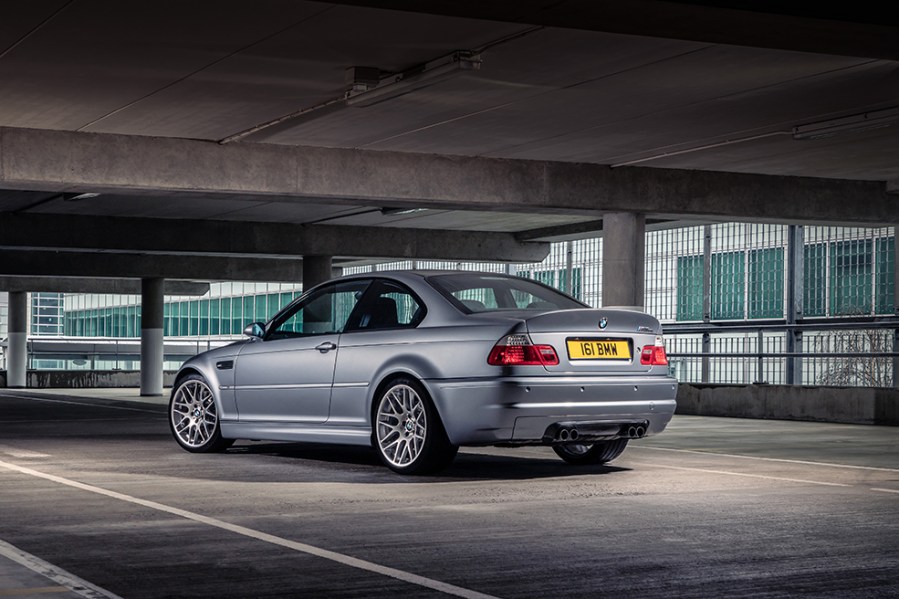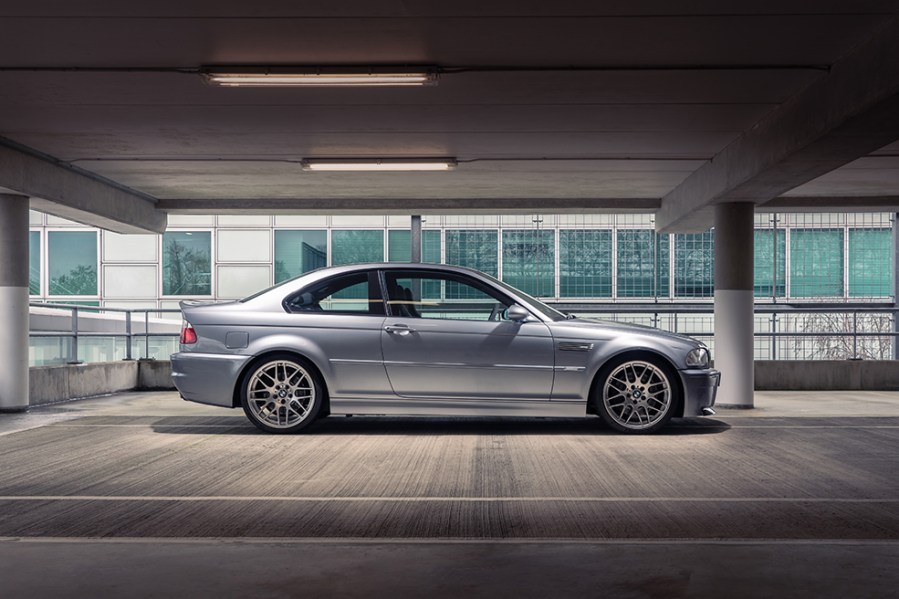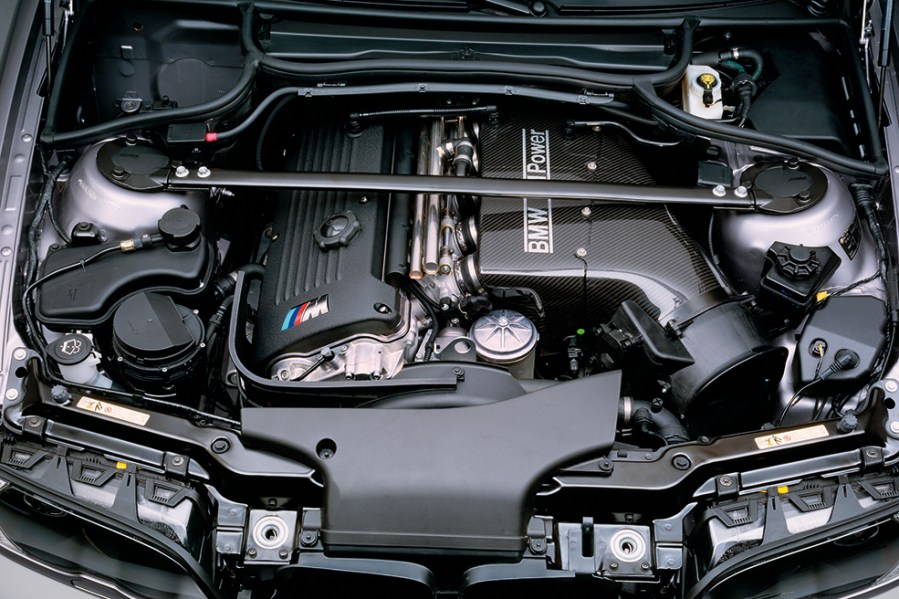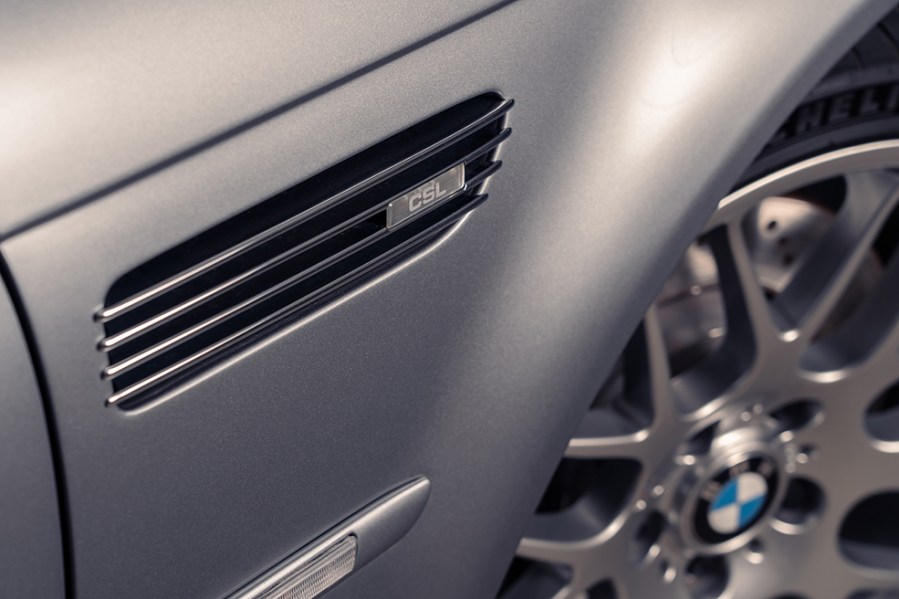Quite simply one of the best sports cars ever made, the E46 M3 is a true modern classic. Here’s how to buy one
Images: BMW With thanks to: Dan Norris, Munich Legends and Barry Sheward, BMR Performance
Launched at the 2000 Geneva Motor Show, the E46 M3 was offered in coupe or convertible forms and featured more purposeful styling compared to previous iterations, with wide arches and a purposeful stance improving upon the E46 3 Series‘ already handsome styling. Under the bonnet was the S54 straight-six, a 3.2-litre unit making 343bhp and driving the rear wheels via a six-speed manual or optional SMG (sequential manual gearbox) transmission.
That motor could rev to 8000rpm and with the M3 weighing less than 1500kg, performance was more than a little brisk: the 0-60mph benchmark was cracked in around five seconds, with top speed limited to 155mph.
But while the muscular engine dominated proceedings, enjoying the E46 M3 wasn’t just about outright pace: handling and response was scalpel-sharp, yet with its controlled ride and luxurious interior this was a car that could happily be used every day.
BMW made the E46 M3 even more special in 2004 with the introduction of the limited-production M3 CSL model. Priced at £58,000 in the UK, the new car brought more power and revised suspension, plus carbon panels and thinner glass to cut around 110kg from the kerb weight. The M3 CS of 2005 was similarly special thanks to stiffer suspension, quicker steering and larger brakes.
The E46 M3’s successor would swap to V8 power, but for epic motorsport character the E46 M3 and its incredible engine take quite some beating.

Bodywork
With the E46 M3 now over 20 years old it’s reasonable to expect a few bodywork issues, so a careful check of the panels is sensible. Serious corrosion is relatively rare, but the main places to examine for rust are the front wings and the wheelarches both front and rear; run a hand around the inner lip of the arch to feel for crusty metal and check for hasty repairs.
Sills and jacking points need checking too – and it’s wise to get the car on a ramp to look for rusty chassis sections and subframes. There’s a good chance of bubbling at the base of the door mirrors, as well as around the boot lock and rear screen.
A somewhat infamous boot floor issue should also be taken into account. It’s actually the ‘rear axle carrier panel’ – to which the subframe carrying the differential mounts – and it can suffer from hairline cracks. Unless already sorted this issue is bound to occur, so inspect carefully.
BMW fixed the issue under warranty for a while, and while there are a few ways to address the problem, specialists can weld in a reinforcing kit for upwards of £1000. It’s important that any fix is done properly so be sure to invest in a professional inspection if you have any doubts.
Naturally, the combination of power and rear-wheel drive in the E46 M3 may have resulted in some drivers exceeding their skill level, so be sure to check the history for any evidence of previous accidents.
With convertible models, take a thorough look at the condition and operation of the soft top as repairs are pricey.

Engine and transmission
The S54 engine in the E46 M3 is considered pretty bulletproof but an unimpeachable service history is very important, with paperwork backing up maintenance from the 1200-mile running-in service onwards.
The S54 engine is not particularly prone to issues with its VANOS valve-timing unit but specialists can rebuild it at a cost of around £850 if it’s rattling. Check the history for proof that the crank bearing failure that affected pre-2003 cars has been attended to.
Skipped oil changes can lead to camshaft and rocker wear, and head gasket failure wasn’t unheard of either – budget about £1500 or so if replacement is needed. Be sure to examine the exhaust system too as flanges have a habit of corroding.
Some owners might have been tempted to invest in performance upgrades so establish what, if any, work has been done; it’s not necessarily a problem but it is important to know what you are buying.
The Getrag six-speed manual gearbox is preferred by most E46 M3 buyers and apart from worn linkage bushes causing a sloppy shift and weak third gear synchro, it’s good for higher mileages unless abused. Be sure to check that the clutch feels healthy.
The alternative was the SMG transmission, which isn’t always trouble-free. The hydraulic pump can play up, resulting in gear selection issues, while clutch wear and judder can be an issue – although a software update from BMW can reduce the latter.
There is the option of converting to a conventional manual set-up, which specialist BMR Performance has done on a number of occasions. You’re looking at £3500 or so if you want a factory look – and the work is reversible.
The limited-slip differential in the E46 M3 can graunch a bit in tight turns, so it’s worth checking this on a test drive. Ideally, the oil should be changed at every Inspection II service; using the correct fluid with a friction modifier can alleviate the noise. If that doesn’t work then a more costly diffential rebuild beckons. In any case, it’s worth checking for oil leaks from input and output shaft seals.

Suspension, steering and brakes
Apart from a tendency for snapped springs (it can be hard to tell while driving so inspect these carefully), there are no inherent issues with the E46 M3’s suspension. Just check for the usual wear in dampers and bushes.
Suspension attention is generally needed after 60,000 miles; budget for an overhaul if the driving experience is anything less than pin-sharp. Given the rightness of the set-up, there’s no real need to take the upgrade route and it’s worth discussing the options with a specialist to avoid making things worse rather than better.
Uprating the E46 M3’s brakes with better discs and pads is a good idea, however. It’s fairly common and an accepted mod amongst enthusiasts, some of whom consider the standard arrangement a bit weak for the performance on offer.
There are no steering issues to worry about – other than the usual worn ball joints and perhaps a steering column coupling that’s ready for replacement – but check the alloys for damage, especially the bigger 19-inch rims, as refurbishment can get expensive.
Finally, make sure that warning lights for ABS and traction control systems illuminate and extinguish correctly.

Interior, trim and electrics
For a car that was so focused on performance and a sharp driving experience the E46 M3’s cabin was notably luxurious, with terrific build and material quality.
Multiple owners and years of hard use might have taken their toll, of course, so assess the overall condition of seat trim and plastics and make sure you’re happy that the wear is commensurate with mileage.
Wear around the seat bolsters is to be expected but shouldn’t be too bad and trimmers can help repair most issues. The rear view mirror is very prone to delaminating but it can be repaired for around £150 which is much cheaper than a replacement item.
Check the door aperture seals; once they come unstuck they can be difficult to re-glue successfully, and as they contain electrical sensors, replacement costs around £300 per side.
The electrics in the E46 M3 aren’t inherently problematic but it’s worth taking the time to ensure everything works, with particular checks on the electric windows, central locking, infotainment system and climate control. Problems with the latter can be expensive to rectify; a previous owner may have just decided to live with an inoperative system.
In any case, the E46 M3 is of an age now where a variety of electrical niggles can crop up, and although a combination of knowledgeable specialists and a decent second-hand parts supply can sort most issues, multiple problems will soon become frustrating.

BMW M3 (E46): our verdict
The E46 M3 remains one of the very best examples of BMW’s famous sports car, regardless of age. With a near-perfect blend of performance, handling and practicality, few performance cars this side of a Porsche 911 can match its breadth of talent.
This generation of M3 has always been popular amongst enthusiasts, and having reached the stage where previous owners are keen to revisit the experience it’s had the effect of keeping values buoyant.
Prices have risen over the last few years but start from around £10,000–12,000. At this level, expect 120,000-plus miles and a number of owners approaching double figures – budget somewhere in the mid-teens for a sound example.
At the other end of the scale it’s low mileage manual models in a desirable colour such as black that will command the highest prices, and expect to pay from the late-twenties to the early-thirties for one of these.
The M3 CSL remains the rarest and most sought-after model, with prices for the very best easily hitting £80,000 and more. Budget around £30,000-35,000 for a lower-mileage example of the M3 CS.
BMW M3 (E46) timeline
1997
E46-generation 3 Series arrives in four-door saloon guise in November
1999
E46 M3 shown at the Frankfurt Motor Show
2000
E46 M3 goes on sale in Germany in October, soon followed by other worldwide markets
M3 Convertible breaks cover in November
2001
M3 CSL shown at the Frankfurt Motor Show
Homologation special M3 GTR arrives with 4.0-litre V8; just 10 examples are made

BMW M3 GTR and its race car equivalent
2003
UK M3 CSL sales start in August
2004
M3 CSL production ends with 1400 made, 422 for the UK
2005
M3 CS arrives in UK with CSL-esque specifcation but option of manual gearbox and no carbon roof or front/rear spoilers
2006
E46 production ends
2007
E90-generation M3 arrives powered by BMW’s S65 4.0-litre V8















